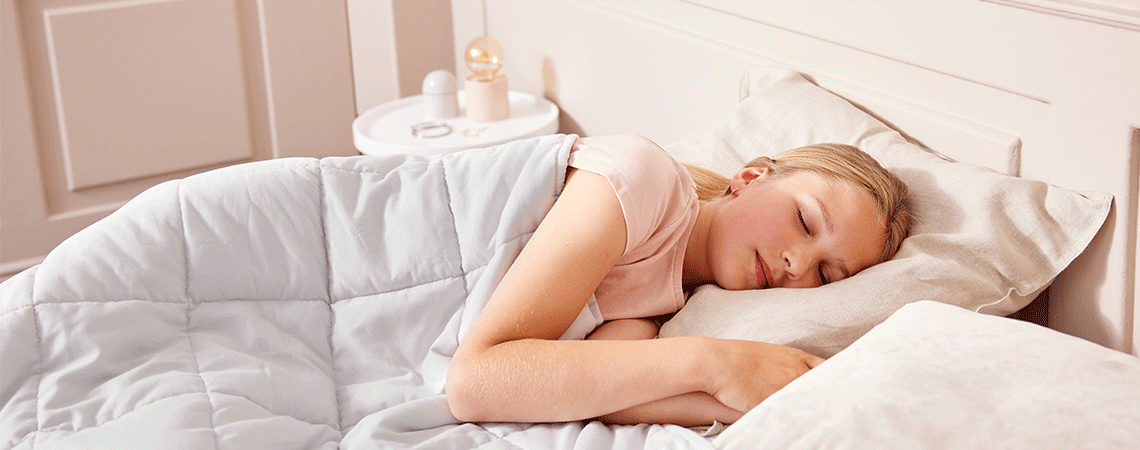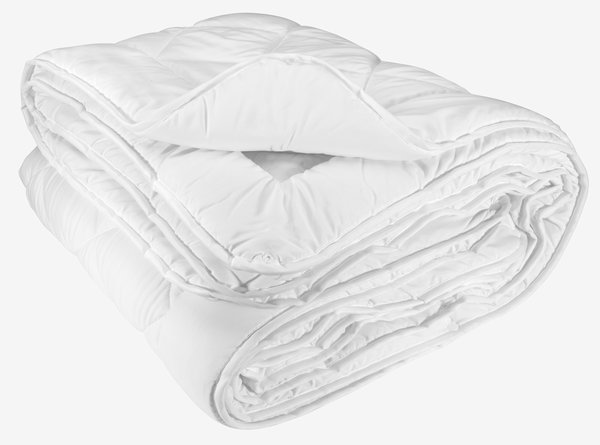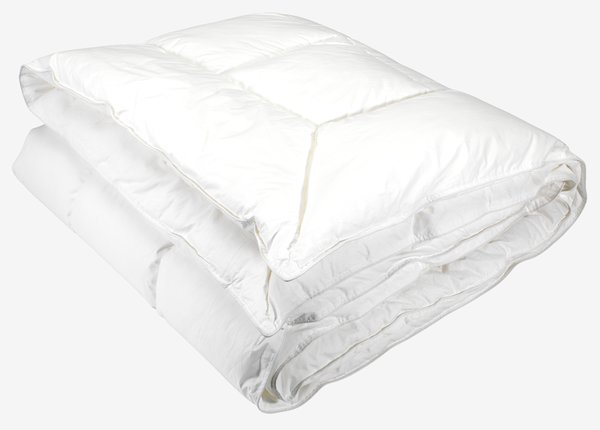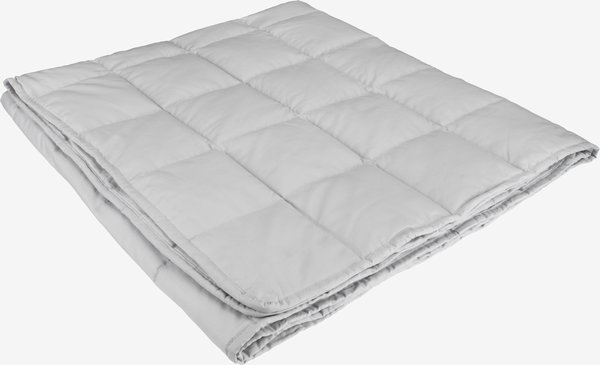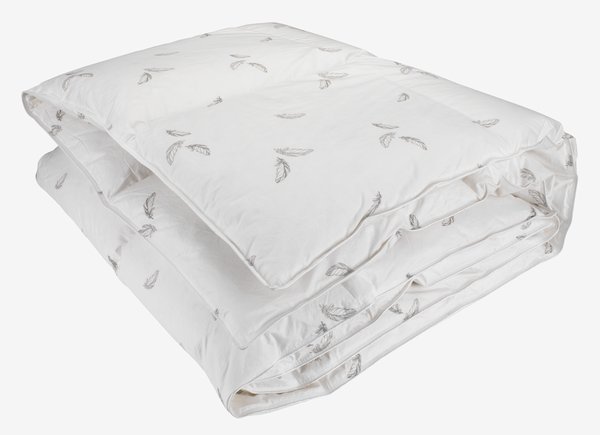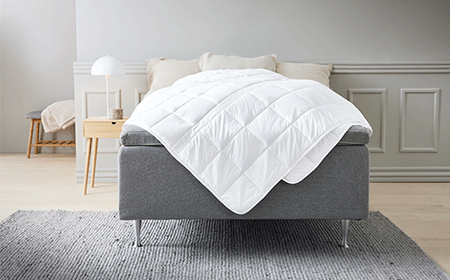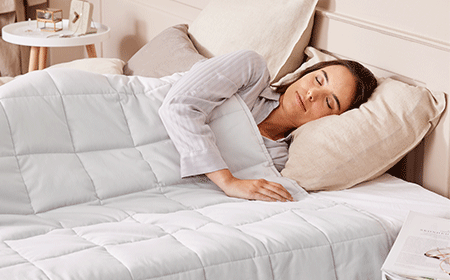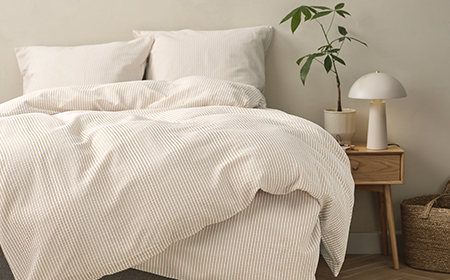What does duvet tog mean?
A tog, also written as TOG, is short for Thermal Overall Grade and is a unit that measures how well a duvet insulates heat. In other words, it indicates how warm it will keep you at night. The higher the tog rating, the warmer the duvet. It’s a standardised measurement that originated in the United Kingdom, which is why you’ll often see it listed as “TOG (UK)” – including in the product specifications of duvets at JYSK.
The perfect tog rating depends on the season and your personal comfort preferences. During summer, a lower tog rating – for example 4.5 or lower – is ideal, while for winter, a higher tog rating of 7 or higher is recommended to stay warm.
The insulation level of a duvet, measured in togs, is influenced by the type and amount of filling. Even if tog isn’t commonly used as a main reference in your market, the same principle applies — the type of filling, how much is used, and how well it traps air will all determine how warm or cool the duvet feels.
Duvets with natural filling such as down offer high insulation with less filling, making them lighter. For example, a warm natural duvet with down filling might have 1000 grams of filling, but to achieve the same tog rating with for a fibre duvet with fibre filling, more filling is required due to the generally lower insulating properties of fibres. This also means that generally, to match the warmth of a natural duvet, fibre duvets will be heavier.
For a light yet warm duvet, opt for one made with a higher percentage of down – in particular Muscovy or goose down – which will provide excellent insulation with relatively little filling. Going with this choice, you’ll get a lightweight and cosy duvet that will still keep you warm.
Three categories for duvet tog and temperature
In JYSK, our duvets are divided into three categories based on tog rating or temperature: Cool, warm, and extra warm. Sometimes, these categories may also be defined by filling weight, fill power or total weight rather than tog alone – but the goal is the same: to help you choose the right warmth level for your needs.
When deciding which level of insulation is best for you, consider your general body temperature at rest – whether you tend to feel hot or cold when sleeping – and your preferred ambient temperature in your bedroom.
Natural duvets: Fill power and temperature
If you’re looking for a new natural duvet, whether you want one to keep you cool or warm, be sure to pay attention to its fill power.
Fill power measures the quality of the down and/or feather filling in a natural duvet. A higher fill power indicates high-quality down that traps more air, resulting in a warmer duvet. Keep in mind that fill power applies only to natural filling— for fibre filling, the appropriate term is fill ability.
Fibre duvets: Fill ability and temperature
If you’re looking for a new fibre duvet rather than a natural one, it’s important to consider its fill ability. Fill ability measures how well the synthetic fibres can trap air, directly affecting the duvet’s insulation capacity. Higher fill ability means greater warmth.
Understanding how fill ability impacts the temperature of a fibre duvet helps you choose the right one to support your needs, so you end up with many nights’ worth of comfortable sleep.
Summer duvet tog: What is a cool duvet?
What type of duvet keeps you cool? The answer is a cool duvet, for example with a tog rating of 4.5. A cool duvet is generally ideal for summertime, as it provides comfort during warmer temperatures. Even in well-insulated homes, many prefer a cool duvet regardless of the season. The primary feature of a cool duvet is its lower tog rating and generally minimal filling, providing slight insulation while maintaining the duvet’s overall feel.
Winter tog duvet: What is warm duvet, and what is an extra warm duvet?
What type of duvet keeps you warm? The answer to this question is of course a warm or extra warm duvet. A warm duvet will naturally keep you warm when the ambient temperature is low such as during wintertime. Duvets classified as warm will generally have a tog rating above 7, while extra warm ones will typically have a tog rating above 10.
When it comes to temperature, a warm duvet is typically somewhere around the middle: For some people, it may be a little too warm in summer, and for others, not warm enough in winter. However, for the average person and average ambient bedroom temperature, a warm duvet is generally a safe choice.
An extra warm duvet is great for those who want to stay warm during cold winter nights or if the ambient temperature of your bedroom is always on the lower side.
Want to know everything about duvets? Check out our ultimate guide to duvets: Which duvet should you choose?

